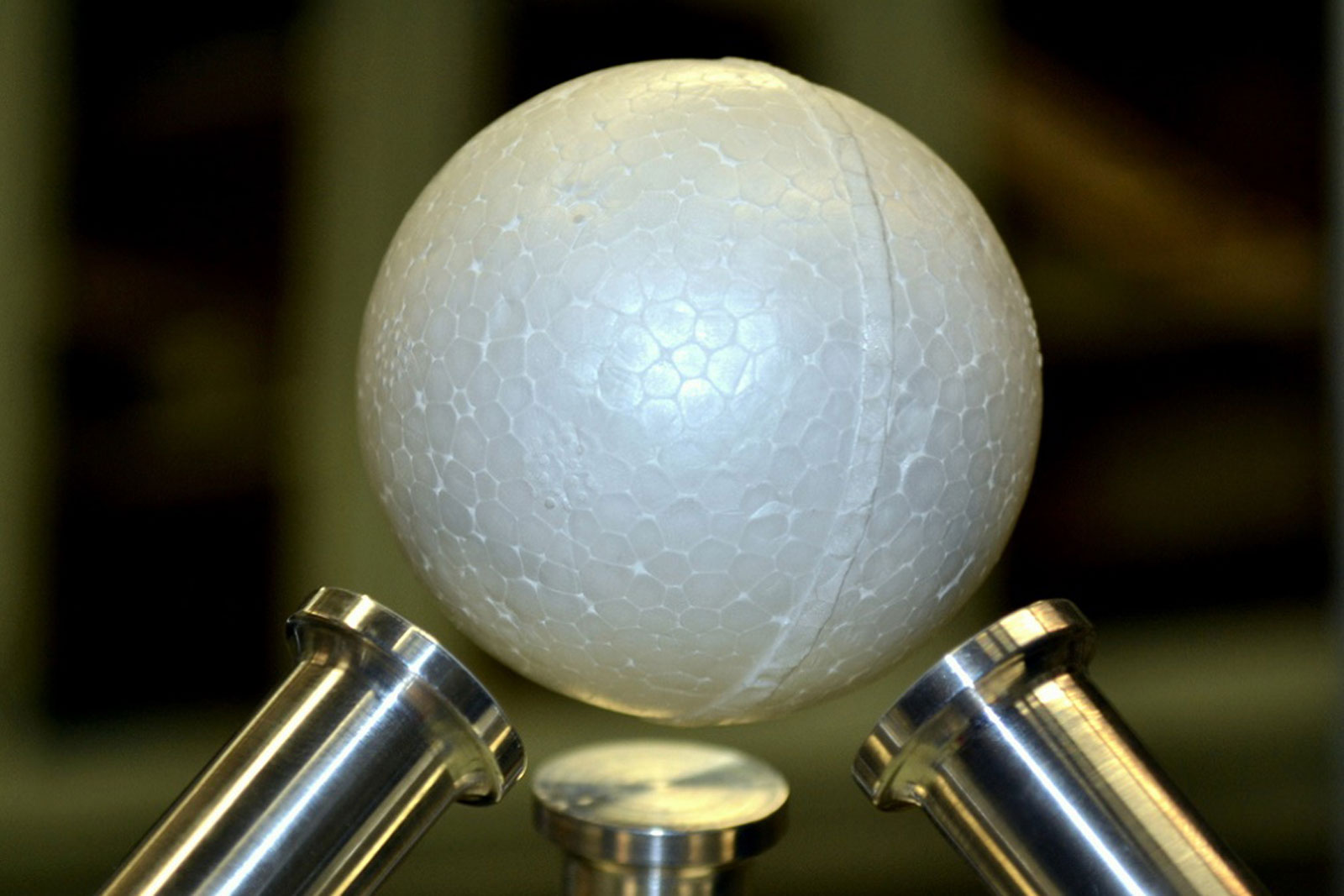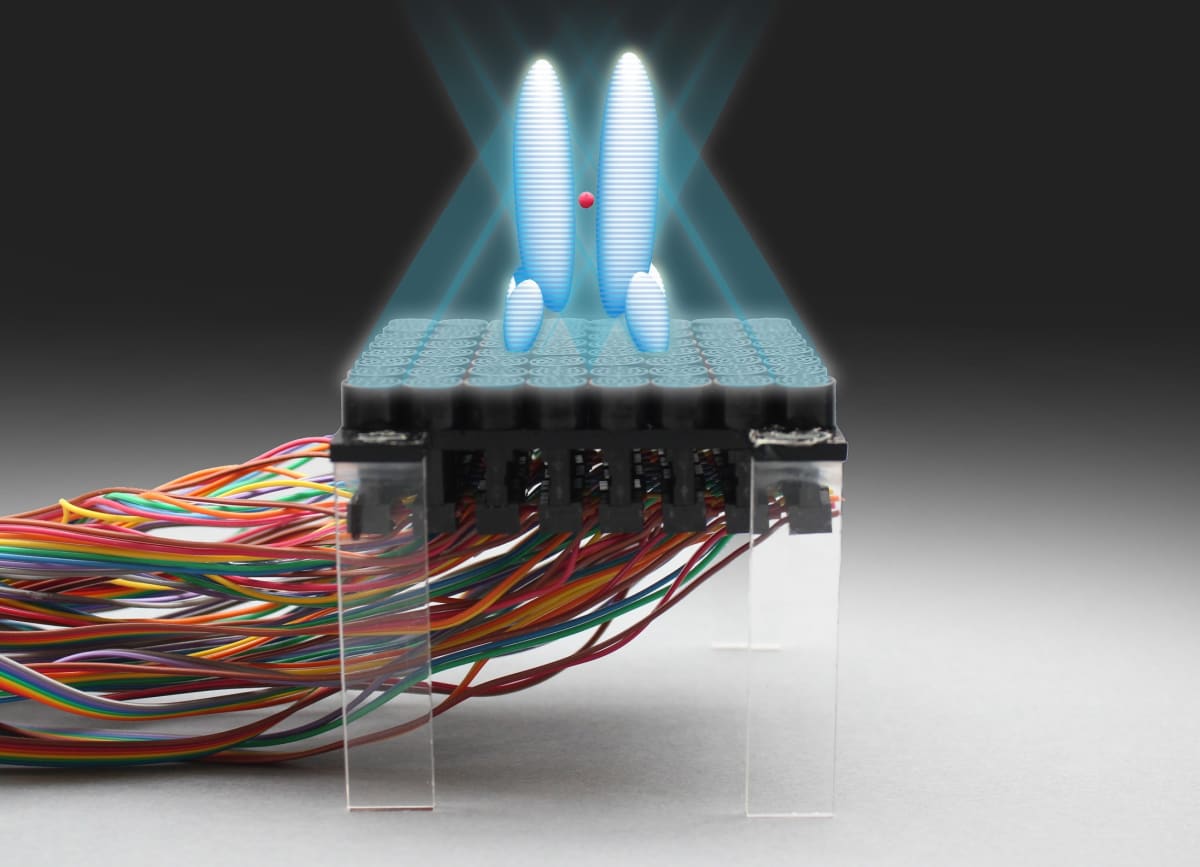
Mice court one another with ultrasonic love songs that are inaudible to the human ear, and researchers, including one of Indian origin, have found that when mice 'sing', they use a mechanism similar...
 Scientists have long dreamed of using acoustic levitation to float objects, but there has been one big catch: you couldn't lift an object larger than the wavelength without being picky about what you're lifting. However, it might not be a problem go...
Scientists have long dreamed of using acoustic levitation to float objects, but there has been one big catch: you couldn't lift an object larger than the wavelength without being picky about what you're lifting. However, it might not be a problem go...
 A team of researchers from the Universities of Bristol and Sussex have developed the world's first functioning sonic tractor beam able to operate outside of a lab environment. The device uses 64 miniature speakers to generate high-amplitude, ultras...
A team of researchers from the Universities of Bristol and Sussex have developed the world's first functioning sonic tractor beam able to operate outside of a lab environment. The device uses 64 miniature speakers to generate high-amplitude, ultras...
Earlier this year, we saw a device that could make objects hover and move in three dimensions using ultrasonic waves. Richard Haberkern’s Ultrasonic Levitation Machine is a lot simpler than that device, but it’s affordable and does what it says on the tin.
The Ultrasonic Levitation Machine uses a small transducer and a reflector to create a standing wave. The device can only accommodate objects up to 6mm in diameter, but that doesn’t make it less fascinating.
Float on to Kickstarter and pledge at least $119 (USD) to get an Ultrasonic Levitation Machine as a reward. Makers can also get either the machine’s blank circuit board or the 70W driver board at the lower reward tiers.
[via Gadgetify]
Last year we saw a robot cane for visually impaired people that warns its user of obstacles with an audible alert. The Virtual Aid for the Visually Impaired or VAVI by grade 10 student Roman Kozak is an even more convenient prototype for a high tech cane. It lets the user search Google Maps and be guided towards his or her destination by voice prompts.
VAVI is not actually a cane but just a short cylinder; instead of direct contact it uses an ultrasonic sensor to detect objects in the user’s path. A vibration motor and a buzzer alerts the user if there’s an obstacle in his way. As for the location search, Roman wrote an Android app that taps into Google Maps. When the app is open, the user can order it to search for a location by saying “go to _____.” The app will look for the destination and will then provide voice prompts to guide the user as he walks.
The app also accepts voice commands for placing a phone call, sending the user’s current location to someone else and for finding VAVI. For that last feature, the app will reach out to VAVI through Bluetooth and activate its motor and buzzer to make it easier to find. Roman also made it so VAVI can be charged wirelessly via induction so the user won’t have to bother finding an adapter and an outlet.
For all its capabilities, Roman estimates that VAVI only costs about $70(USD) to produce. Check out Roman’s website for more on his invention.
[via Hack A Day]
Behold witchcraft! Some crazy mages who call themselves scientists are making stuff levitate using ultrasound waves. Check out the video below. It demonstrates three-dimensional, mid-air acoustic manipulation, aka levitation. Aka witchcraft!


Seriously, this video just makes my brain hurt. It is amazing. Check out all of the details on their website. This amazing science is the work of professors Yoichi Ochiai, Takayuki Hoshi, and Jun Rekimoto. They have powerful magics indeed.
[via ViralViralVideos via Geekosystem]
A few months ago we featured iSketchnote, an iPad cover that can record and digitize handwritten or handdrawn notes. If chipmaker Qualcomm has its way, that feature may be integrated into the next wave of tablets. To show off the power of its upcoming Snapdragon 805 processor, Qualcomm will be displaying what it calls Ultra Sound at the 2014 Consumer Electronics Show (CES).
Like iSketchnote, Ultra Sound copies doodles made with ink and paper in real time. The prototype shown in the video below requires a digital pen that’s also an ink pen. When you use the digital pen on paper, it emits ultrasonic vibrations. Those vibrations are picked up by microphones embedded in the Snapdragon 805-powered tablet and then analyzed to replicate the paper sketch on the tablet’s screen.
It would be nice if Ultra Sound worked even if the tablet was in sleep mode, so you can keep writing or doodling for long periods of time knowing that your work is being backed up in real time.
[via SlashGear]
Instructables member Patrick aka Mizchief100 made what he calls the Visual Impairment Aid or VIA, a wrist-mounted device that alerts the wearer of nearby objects by vibrating and emitting a beeping noise. It’s like the Spider Sense toy but in a more practical form, not to mention one that you can build yourself.

Like the Spider Sense toy, the VIA uses an ultrasonic distance sensor. Patrick added a buzzer and two vibrating motors to provide feedback. He also made a 3D-printed case for the device, adding Braille labels to its power switch and two buttons. One of the buttons lets the wearer select whether to use haptic, audio or both types of feedback. The other button switches between long and short distance modes: “…in short distance mode the beeping/vibrating is scaled so it’s easier to tell differences between things close up (<3 feet) and long distance mode makes it easier to tell things far away (~10 feet max).”
Head to Instructables to find out how you can make your own VIA. If you’re looking for a more practical version of Patrick’s device, check out the UltraCane.
[via Hacked Gadgets]
Sure, we've seen rats control other rats, but that won't give us a legion of mind-controlled creatures to unleash upon an innocent public, will it? Harvard Medical School may unwittingly assist with solving our (rather misguided) plight, as it just experimented with a system that lets a human mind trigger actions in a rat's motor cortex. The test had sensor-equipped humans watch a screen that flashed in sync with their EEG brain patterns for visual stimulation; as soon their attention shifted to controlling the rat, they triggered an ultrasonic pulse that twitched the rodent's tail. There's a few problems with the implementation beyond the obvious lack of autonomy for the poor target creature, though. The rat's anaesthetized state likely affected the results, and the system isn't currently sophisticated enough to map specific thoughts to corresponding actions. The Harvard team is working to refine the technology, however, and there may be a day when we can satisfy our megalomania... or at least, put the Pied Piper on notice.
Via: New Scientist
Source: PLOS (PDF)
